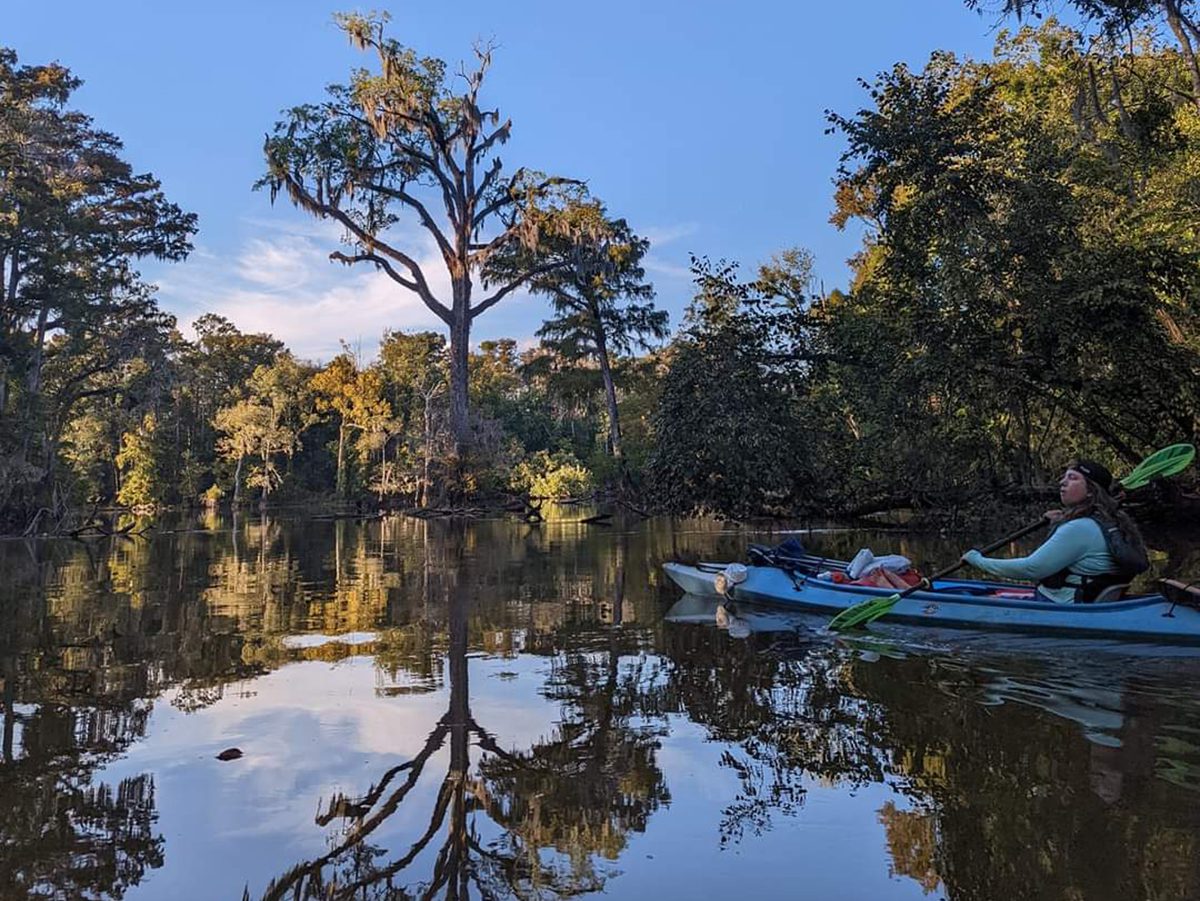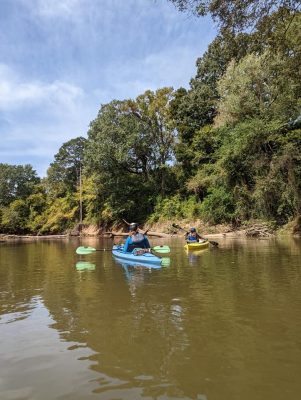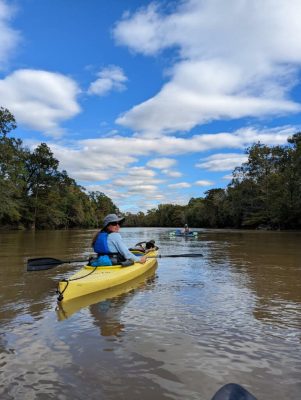
Fifty years ago, in October 1972, the United States passed the Clean Water Act. This game-changing legislation regulates the discharge of pollutants into the country’s waterways, and establishes surface water quality standards. Part of the goal was to make waters fishable and swimmable by the 1980s.
“We know in retrospect that we’ve come a really long way,” said Samantha Krop, Neuse Riverkeeper for Sound Rivers. “But also, the Clean Water Act hasn’t yet delivered on that promise.”
Supporter Spotlight
Beginning in the Piedmont and emptying into the Pamlico Sound, the Neuse River is the longest that runs in its entirety through North Carolina. This month, three riverkeepers paddled over half of the river’s total distance to bring attention to the Neuse’s wonders and plights. At just shy of 150 miles in 11 days, the paddlers saw ample wildlife, a hurricane, sources of pollution and the most incredible sunsets.

Along with Krop, the paddlers were Pamlico-Tar Riverkeeper Jill Howell and Emily Bowes, the Rogue Riverkeeper from southern Oregon. Just as important are their dogs Miller and Charlie Girl. Keep reading to follow along on their journey.
Paddling Through the Let’Lones
Day 1 started with sunny weather from the put-in point at Smithfield Town Commons Park. The paddlers had about 15 miles to go through a stretch of the Neuse that is largely undeveloped and unpopulated — with people, that is. Though the paddlers didn’t see any other humans on the river, they did see a lot of river creatures, including deer, otters, and possibly even a marmot. The Neuse River derives its name from the Neusiok Tribe, and it means “peace” — something the paddlers would resonate with multiple times throughout their journey.
This section of the Neuse is known colloquially as the “Let’Lones,” a nod to the fact that this area is home to snakes and formerly a hub for illegal alcohol traders, two groups “best left alone.”
After spending their first night camping on a sandbar, Day 2 was another 15-mile stretch through the Let’Lones. On this day, in addition to witnessing many of the wonderful things about this section of the river — kingfishers, hawks and turtles — the paddlers also made note of the undercut banks along the river, a symptom of erosion.
Supporter Spotlight
Nearby development can increase erosion in a river like the Neuse. The addition of impermeable surfaces like pavement increases stormwater runoff, causing the riverbanks to collapse. This causes issues for the river like poorer water quality, which can harm the plants and creatures that call the river home. The paddlers saw evidence of locals trying to combat the erosion — concrete bags or cinder blocks along the shoreline — but these things aren’t real solutions.
The paddlers pulled their kayaks out of the river at the Richardson Bridge wildlife boat ramp. Instead of camping, they packed into an Airbnb — the beautiful weather had given way to the heavy rain of Hurricane Ian.
Waiting Out the Hurricane
As the rain came down on Day 3, the paddlers opted to stay off the river for safety. Fortunately, this did not set them behind schedule, as they had always planned to take a day off at some point during the paddle.
While North Carolina avoided the extensive damage by Hurricane Ian that states like Florida saw, intense rain and wind blew through the state, and five people lost their lives in storm-related incidents. What it means for the paddlers is that when they get back on the river the following day, there will be a lot more water in the river. This is actually something the paddlers had in mind when they named their trip “Neuse River Rising.”
“We really wanted something that symbolized the power of communities along the Neuse to be advocates for and active participants in the watershed,” Krop said. “There’s also obviously a nod to climate change, and sea level rise and flooding, and the fact that this is something in our future.”
The Coal Ash Catastrophe
On Day 4, the paddlers set out on a very different river than the one they left two days before. The water is much higher and therefore much faster. In developed areas, big flushes of rain like this tend to wash pollutants into the river. These inputs can cause problems like algal blooms and fish kills.
They are joined by Alan Capps, a Sound Rivers ally and owner of Down East Kayak Outfitter. Their first stop is in Goldsboro, site of Duke Energy’s HF Lee plant, and an environmental catastrophe that occurred after Hurricane Florence four years ago. Heavy rains flooded the coal ash storage ponds, which held approximately 1 million tons of coal ash, resulting in disastrous pollution for the river.
Coal ash pollution has long been a concern in North Carolina, and in the early days of 2020, the issue came to a head. A landmark settlement forced Duke Energy to remove all their coal ash ponds across the state. The company is in the process of excavating them.
“One thing that we’ve learned is that it’s not safe to store coal ash alongside our waterways, especially in areas that could flood and have flooded before,” Krop said. “But we don’t want to forget. So as we go by this location it’s important for us to remember what can happen if we’re not careful about how we store toxic waste, and if we’re not thoughtful about the way that our rivers change with increased flooding and climate change.”
After 19 miles, the team camped out on a friend’s property.
How are Forever Chemicals Affecting the Neuse?
On Day 5, the paddlers made their way past a park for all-terrain vehicles and Seymour Johnson Air Force Base. The paddlers took the time to examine how some of these different land uses impact the river.
According to the North Carolina Department of Environmental Quality, there should be a 50-foot riparian buffer between the Neuse River and activities that disturb the land. These rules help filter stormwater runoff before it can reach the river, and mitigate the effects of erosion. Paddling by the Busco Beach ATV Park, the team observed ATV tracks going all the way down to the river.
“This is one of those things where we would advocate for recreation in a responsible way,” Krop said.
At the Air Force base, the paddlers stopped to collect a water sample. They’re testing for per- and polyfluoroalkyl substances, also known as PFAS. Because they take such a long time to break down, PFAS are sometimes colloquially referred to as “forever chemicals.” PFAS are ubiquitous — they’re found in water, air and soils across the world, and detected in human blood. It is suspected that they are associated with detrimental health effects. The Environmental Protection Agency has been aware of PFAS since 1998, but many environmental advocates find the agency’s regulations for PFAS, which are still evolving, unsatisfactory. The paddlers collected a water sample in the vicinity of the air force base because a common source of PFAS is firefighting foam.
Locations like this are a stark reminder for the paddlers that it is the 50th anniversary of the Clean Water Act.
“I feel like when you’re celebrating anniversaries, it’s sort of like you’re celebrating this static thing,” Howell said. “When in fact, the Clean Water Act has changed over time.”
Earlier this month, the Supreme Court heard arguments in a case that could decrease the amount of power the EPA has to regulate the discharge that goes into wetlands. This comes just months after the Supreme Court ruled to limit the EPA’s ability to curb emissions under the Clean Air Act.
“It’s a huge deal in terms of defining the scope of what types of waterways and wetlands are protected under the Clean Water Act and what are not,” Howell said.
After 10 miles, the paddlers camped at the Highway 581 boat ramp.
Community Along the River
Day 6 featured a magnificent paddle past Cliffs of the Neuse State Park — this is a 90-foot-tall cliff formation that took shape millions of years ago when the combined forces of a shifting fault in the Earth’s crust and the carving power of the river left exposed layers of sand, shale, clay and more. For the paddlers, this was one of the highlights of the trip.
After a cold and windy 15 miles, the paddlers pulled off the river in the small town of Seven Springs, where they were warmed up by a home-cooked meal courtesy of Ronda and Robert Hughes. Since Ronda is the mayor of Seven Springs and Robert is one of the town’s commissioners, the paddlers were able to learn a lot about the history of the town and its future. Seven Springs is known for its history of offering spring mineral baths (though there are actually nine springs, not seven), causing the town to become a hub for physical and mental rejuvenation. Seven Springs is in its own process of rejuvenation now, as they continue to address damage caused by Hurricane Matthew in 2016. After talking about flood resilience and what the town has to offer, the paddlers left Seven Springs with a lot of appreciation for the area.
Paddling Past Hog Farms
The 17 miles on the river for Day 7 were bright and sunny. The paddlers passed some hog farms on this stretch of the river. Many North Carolina hog operations store swine waste in large open pits, which can flood during hurricanes. Even with a riparian buffer, this waste can result in pollution to the river during floods. Not only are the fecal bacteria a health risk, large nitrogen inputs can increase the frequency and intensity of algal blooms.
As they floated by, the paddlers talked about the swine farm buyout program, a North Carolina state program that will compensate CAFO, or concentrated animal feeding operation, farmers to remove their operation from the floodplain, in order to keep hog waste out of the river. No funding was allocated to this program this year.
In the evening, the paddlers spent the evening with their friend Bob Griffin, just upstream of Kinston. The next morning, they set out on Day 8 — only 7 miles. While Capps had left them in Seven Springs, they are joined by another friend, Kelsey Curtis, owner of Knee Deep Adventures, an outfitter in Greenville.
The paddlers have been seeing evidence of beavers along the river — something that Bowes noticed immediately, being from Oregon, also known as the Beaver State. This is the third year that Sound Rivers has done a paddle like this, but this is the first time that they’ve had a riverkeeper from across the country joining them. According to Krop, it’s been a great learning experience for the three riverkeepers to compare notes.
“It’s amazing how many of the same issues that we deal with out here in North Carolina, Emily’s dealing with in Oregon,” Krop said. “And then also, because of the geographical differences and the differences in the members themselves, there’s also a lot of unique struggles.”
After a full week on the river, the paddlers saw another kayaker for the first time. They had a lighthearted conversation with the stranger, but also recognized that they wished that more people were recreating responsibly on the river.
They spent the evening in Kinston at Neuseway Nature Park, and rounded out the evening with a trip to Mother Earth Brewing.

A Sound Rivers Investigation
Day 9 featured the longest distance paddled at once by the team — 25 miles through a beautiful stretch of river, with cypress trees, flowers and wildlife. Along the way, there were two notable stops:
First, they paddled past Adkin Branch, a stream that flows through Kinston and drains into the Neuse. Adkin Branch faces a lot of issues with pollution, but a local group called Kinston Cares recently received a large grant aimed toward research and engagement with Adkin Branch.
Then, the team also stopped at the spot where Contentnea Creek meets the Neuse. Contentnea Creek flows through several towns on the way to the Neuse, and is a popular spot for recreation. But it’s also a spot that Sound Rivers has been monitoring with extra focus lately. As those who are familiar with Sound Rivers are aware, the organization engages in not just advocacy and education but also investigations and monitoring.
During a routine flyover monitoring excursion in August, the riverkeepers noticed that the waste lagoon at a swine CAFO biogas facility near Fremont didn’t look quite right. After digging into public records, Sound Rivers discovered that in May the lagoon — where the facility was storing swine waste, decomposing food and hog carcasses — had overflowed and 3,000,000 gallons of this harmful material had spilled out when the digester cover ruptured. Sound Rivers is continuing to investigate the extent of the pollution, and what effects it will have on the ecosystem.
After this long-haul paddle, the kayakers paddled into the sunset and spent the night at the Maple Cypress Wilderness boat launch. They ate a fresh fish fry, courtesy of friend and Sound Rivers member Pat Griffin.
The Final Stretch
Day 10 was the team’s last full day on the river. Hotter than the previous days, through the course of 11 miles the paddlers got to watch the water transform from a swamp-like environment into a more estuarine river as they got nearer to the coast.
They made camp at Cow Pen Landing boat ramp, accepting dinner from some generous locals.
The next morning, the team got out paddling in time to see a mind-blowing sunrise, as well as make a few important stops along this stretch of river. First up was West Craven Middle School, which partnered with Sound Rivers to install a green stormwater project. This is part of Sound Rivers’ Campus Stormwater Initiative, which works with schools to figure out what kind of stormwater management system works best for them. Having seen many of the effects of stormwater runoff on the river in the preceding days, the paddlers felt really proud as they passed West Craven Middle School.
They also passed the International Paper Co. plant. Paper companies use various chemicals to transform wood into paper, some of which end up back in waterways because of a special permit that allows for waste discharge as long as that waste doesn’t exceed certain levels of things like nitrogen and phosphorus.
Passing by the paper plant, the paddlers once again worried about the impact of PFAS, which are not yet as thoroughly regulated as some other chemicals. It’s a reminder that for all the victories of the Clean Water Act in the last half century, the issues continue to evolve.
“There’s a lot to celebrate, and a lot more to do,” Howell said.
By the time the paddlers reached Glenburnie Park in New Bern, they encountered choppy waters and opted to forgo the last few miles of the paddle out of safety. With 150 miles in the bag, the paddlers blogged after their final day:
“The Neuse River sure wore us out, but it also filled us up. Walking away from this adventure of a lifetime, each of us are in awe of the impeccable beauty of the Neuse River and inspired by the many, many opportunities for exploration that it offers. We are also inspired to take action to protect it, and have a not-so-short list of the many next steps we plan to take to address pollution and advocate for the river and all who rely on it.”
Tired but also content, the team will be back on the river sometime soon.
“I can’t wait to get back out here and explore so many of the tributaries that we passed,” Krop said. “There is so much opportunity for getting out on the water and having all kinds of adventures, and this is just the beginning.”








